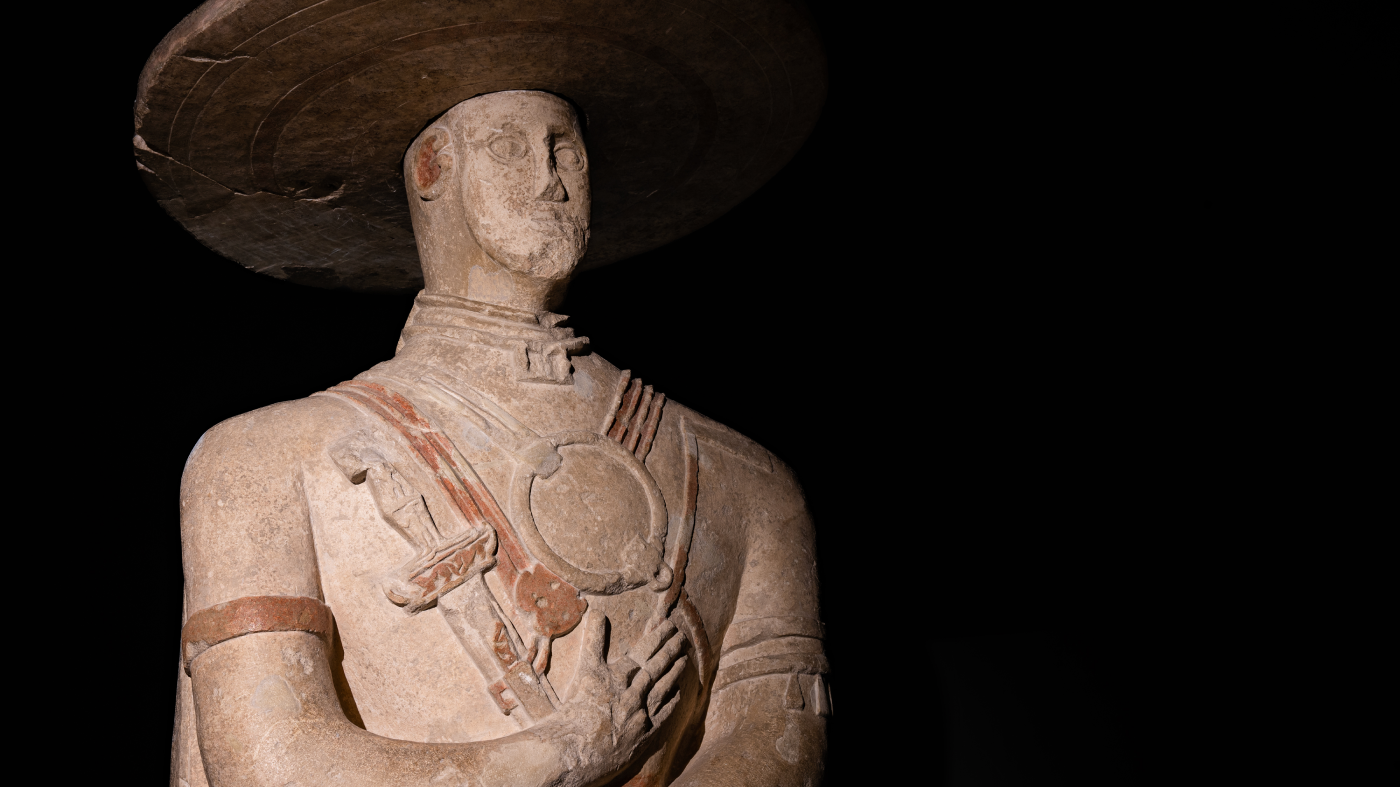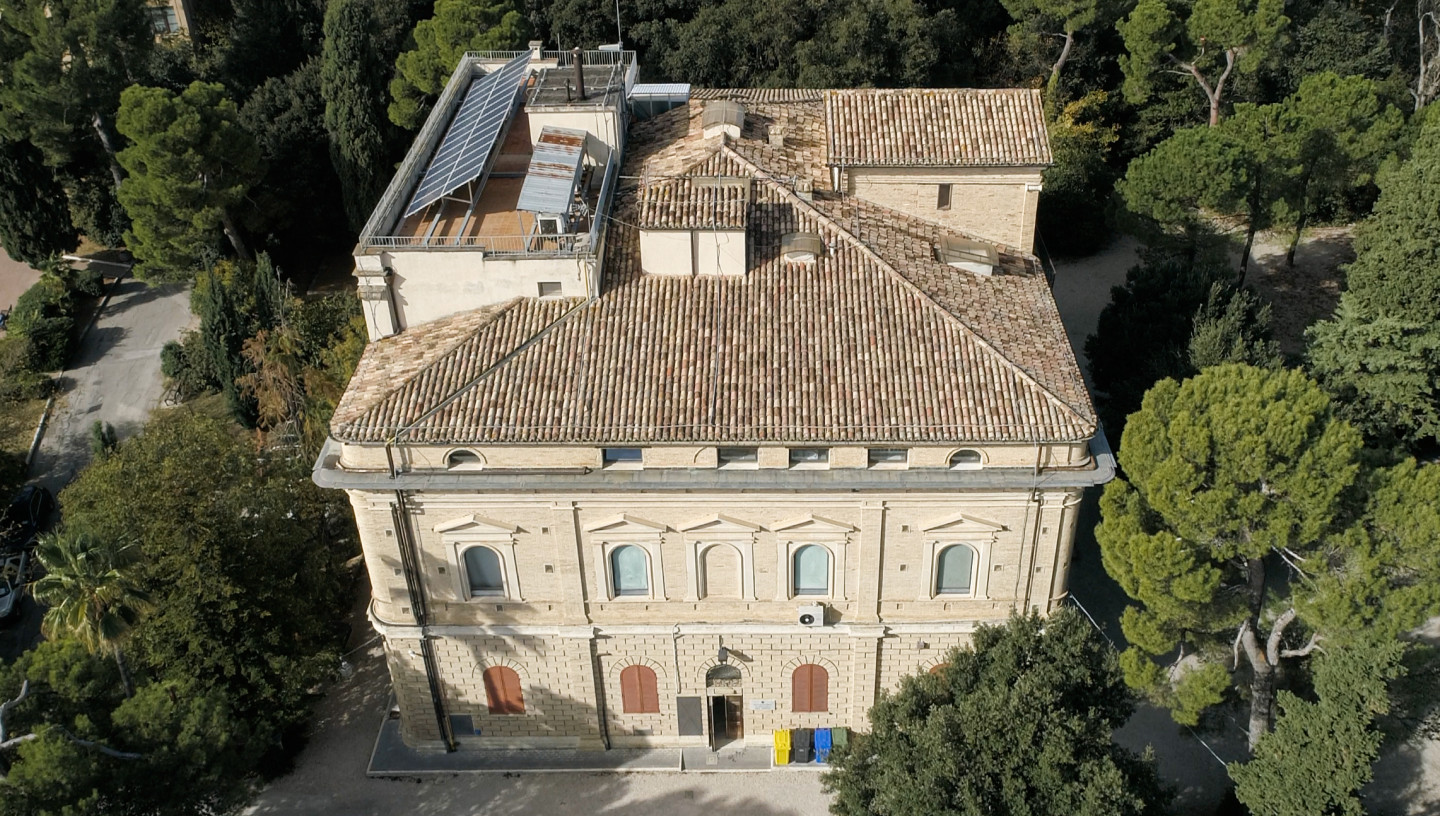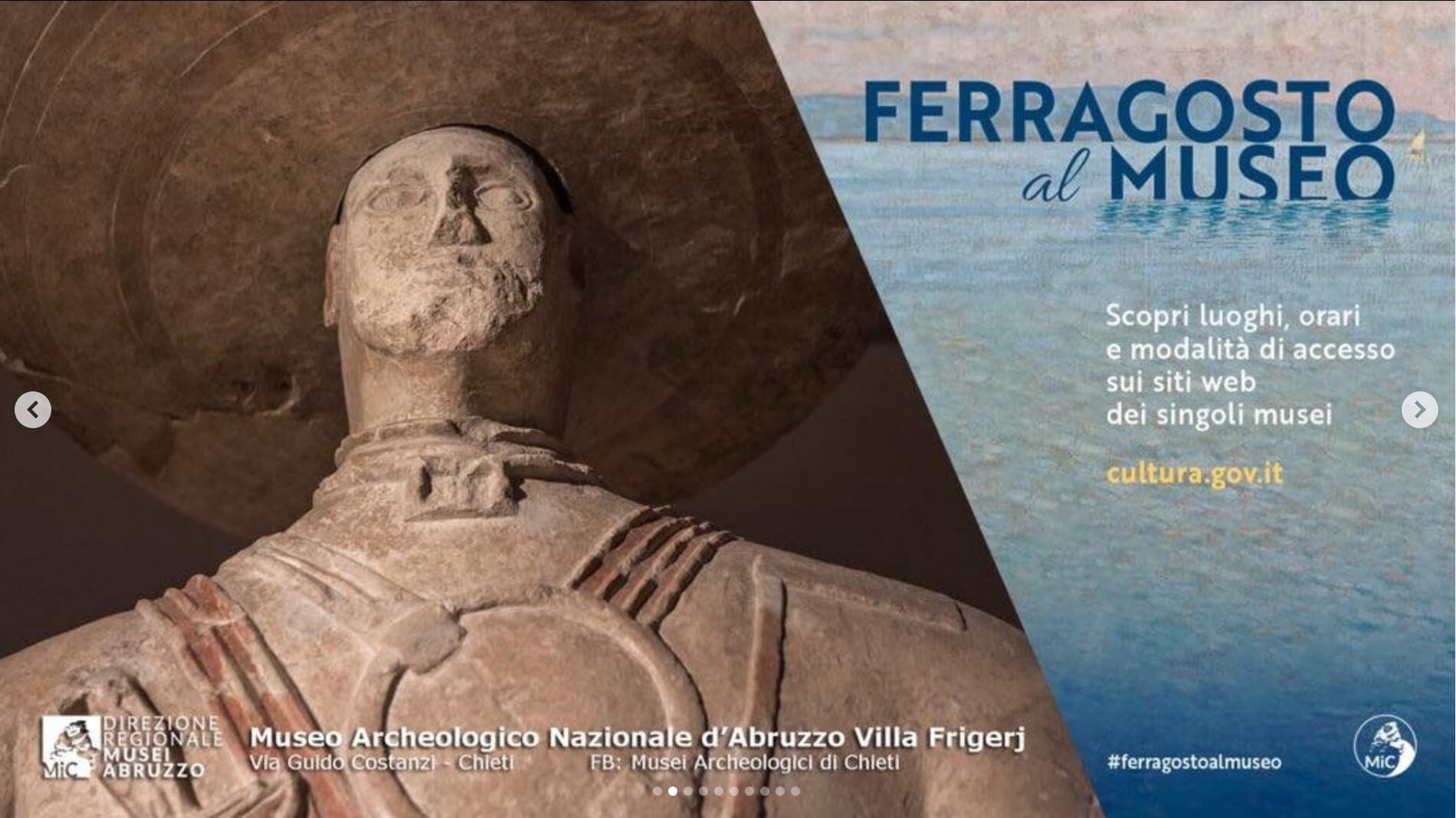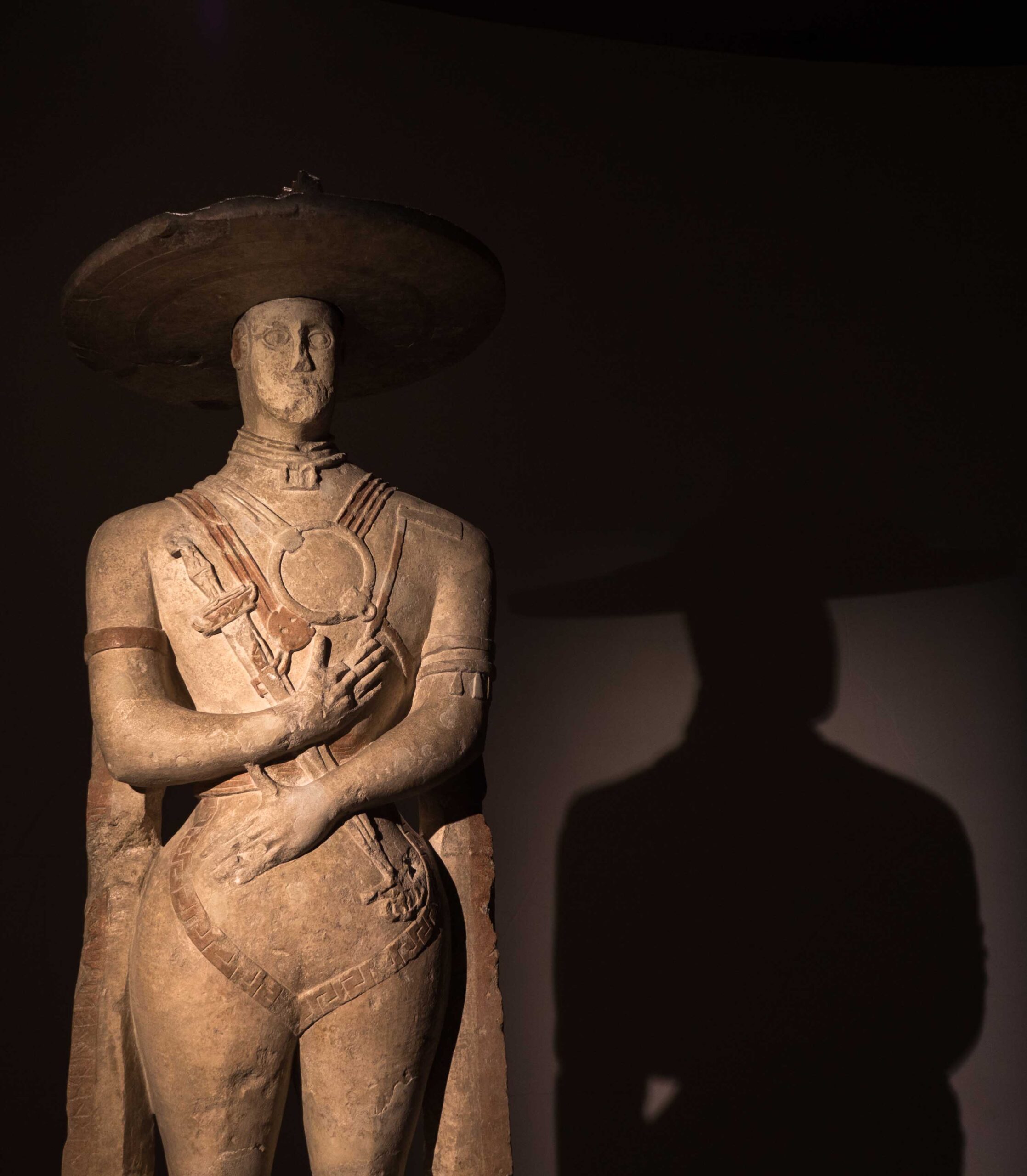ITALIANO
Prima metà del VI sec. a.C.
Statua
Calcare
VI secolo a.C.
Capestrano (AQ)
La celebre statua fu rinvenuta fortuitamente nel corso di lavori agricoli a Capestrano nel 1934. L’eccezionale scoperta diede avvio ad una serie di indagini archeologiche che portarono all’ individuazione di altri frammenti scultorei, quali il busto femminile ora noto come la “Dama di Capestrano”, un ulteriore busto maschile, in seguito battuto all’asta e acquistato per una collezione privata, e due basi litiche, oltre a 33 tombe.
La vicinanza dei frammenti alla tomba 3, a fossa, dal ricco corredo in parte disperso e l’orientamento peculiare di questa sepoltura rispetto alle altre ha fatto ipotizzare che la tomba potesse appartenere ad una figura di alto rango, che fosse racchiusa da un tumulo o da un circolo di pietre e che le statue avessero la funzione di ornare la sepoltura. Le caratteristiche scultoree del Guerriero e della Dama inducono infatti a considerarle non solo come opere prodotte su commissione da uno stesso artista ma anche come parte di un unico gruppo scultoreo raffigurante personaggi del medesimo nucleo familiare titolare della tomba.
La statua, eccezionalmente conservata per intero e con tracce visibili di colorazione, è realizzata in pietra calcarea locale e rappresenta una figura maschile stante, con piedi posati su una base litica e inquadrata lateralmente da due pilastri fino all’altezza delle spalle. Il Guerriero indossa una tòrque al collo, delle armille, una mitra sostenuta da un cinturone stretto lungo i fianchi, a protezione del ventre, e infine calzari. Il preminente ruolo sociale è evidenziato dalla dettagliata raffigurazione di armi da difesa, da offesa e da simboli del potere. Tra le armi da difesa figurano il grande elmo da parata, a larga tesa, con il cimiero di penne, e i dischi corazza indossati sul petto e sulla schiena. Tra le braccia piegate, una sul torace e l’altra sulla vita, sono presenti le armi offensive: la spada lunga, detta di tipo “Capestrano” e un coltello che serviva per mantenere tagliente il filo della spada. Le impugnature di entrambe le armi presentano decorazioni con fregi antropomorfi e zoomorfi. Armi da offesa sono anche le lance con la punta rivolta in alto raffigurate sui pilastri laterali. L’ascia tenuta con la mano destra potrebbe richiamare le funzioni religiose e di potere prerogative dei capi.
La statua presenta anche un’epigrafe, incisa verticalmente su uno dei pilastri, all’ interno di una fascia di colore rosso. Il testo identifica il personaggio come Nevio Pomp(uled)io qualificandolo, molto probabilmente, come re. Stando alle caratteristiche tecniche, stilistiche ed epigrafiche è possibile datare il guerriero di Capestrano alla prima metà del VI secolo a.C.
La buona conservazione del colore rosso del Guerriero e della Dama suggerisce che le statue non rimasero esposte a lungo alle intemperie e che le fratture e le lacune nella zona inferiore del monumento siano imputabili ad un atto intenzionale di distruzione per operare una sorta di damnatio memoriae.
ENGLISH
The “Capestrano Warrior” (statue)
Limestone
6th century BC
Capestrano (AQ)
This famous statue was discovered by chance in 1934, during farm works conducted on the land of Capestrano. Because of this unusual find, archaeological investigations were carried out for a better understanding and knowledge of the area. 33 tombs were identified and excavated and the bust of a female statue, today known as the “Capestrano Lady”, was also found. Among the most significant finds were the bust of a male statue – sold during an auction and bought for a private collection – and two stone bases for statues.
Some fragments of the statues were found near tomb 3, a pit grave with rich goods, which were partially lost. The tomb was oriented in a different way to others and was probably surmounted by a small mound or by a stone circle and decorated with the statues found nearby. The characteristics of both the Warrior and the Lady suggest that they were made by the same artist to be part of one group representing members of the same wealthy and powerful family to whom the tomb belonged.
The limestone statue is entirely preserved and has traces of red colour still visible on the surface. It represents a standing male figure. The feet are placed on a stone base, while the sides are held by two small pillars. The warrior wears a torque around his neck, armillae (bracelets) on his arms, a kilt to protect his belly, held around the waist with a belt, and sandals. His social role is emphasized by the weapons: the large parade helmet with a crest made of feathers, the single disc-armor, composed of a disc to protect the chest and another to protect the back. The arms are bent over the chest and hold a long sword and a knife, possibly used to sharpen the sword, and an axe, perhaps used for ritual or religious purposes. The handles of the swords and of the knife are embellished with decorations representing human figures and animals.
On the pillars there is a spear per side, with the point upwards. On the left pillar there is also an inscription, incised on a red painted band, that names the figure represented in the statue as Nevio Pomp(uled)io.
On the basis of the stylistic and epigraphic characteristics, the statue is dated to around the first half of the 6th century BC.
The good preservation of the red colour on the statues of the “Capestrano Warrior” and the “Capestrano Lady” may indicate that these artifacts were not exposed to the weather for a long period of time. The breaks in the lower part may be clue for an intentional disruption, a sort of damnation memoriae (memory condemnation).






